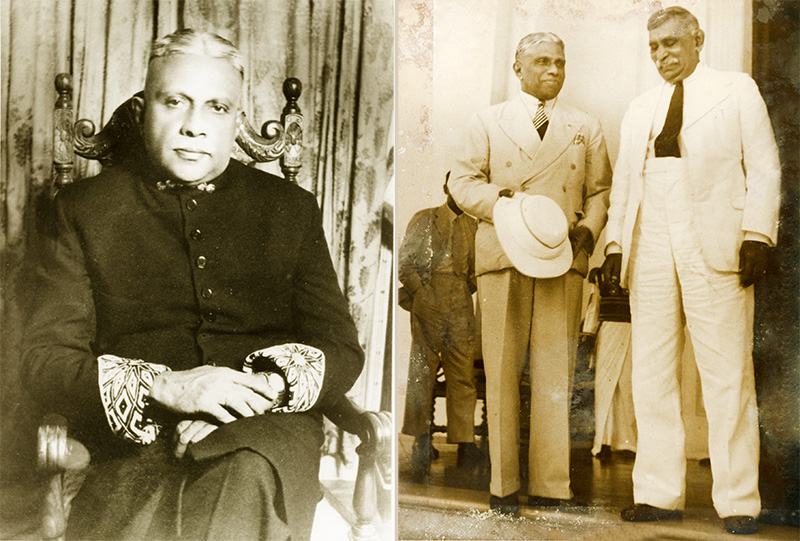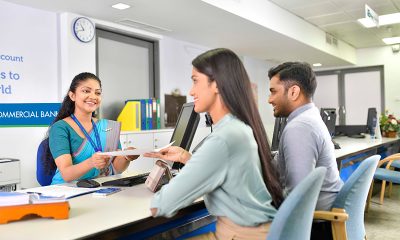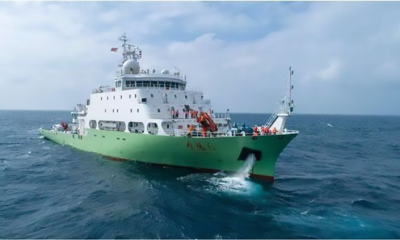Opinion
Dr. Ajantha Ranasinghe:

The Unsurpassable Wordsmith
by SVD Kesarralal Gunasekera
‘What a beautiful and remarkable human being’ is what comes to my mind every time I think of Dr. Ajantha Ranasinghe. He was an award-winning lyricist, a journalist, a writer and a critic. But what really is etched in my mind is what he was as a human being. There is so much to learn from his life. I am not appreciating him solely because he was a popular personality but because of his unassuming personality that made our lives so complete.
Lyricist par excellence
Dr. Ajantha was a fantastic lyricist. His style, as well as the varieties, are unique. He has been a lyricist for the Sinhala cinema for decades. As a young student, when we watched films ‘Lyrics: Ajantha Ranasinghe’ would appear on the big screen. From ‘Gamey Kopi Kade’ (Sanath Nandasiri) type of upbeat songs, which creates a series of images in our minds about a small coffee stall in a village, to ’Paarami Dam Puramu api denna’ (Neela Wickramasinghe) which speaks about affection of siblings, and to ‘Kalpana lowa mal waney’ (Abeywardhana Balasooriya) which expresses the depths of romantic love, Dr. Ajantha had the ability to select the words suitable for each singer. He had a rich vocabulary from which he culled the right words and turned it into a song.
Not only did he bring Buddhist philosophy into his songs, in ‘Mey Ayurin Api Sansarey’ (T M Jayaratne), but he was equally brilliant in writing “Bodhu Gee” which touched the souls of the people. ‘Nirvana Swarna Dwarayen’ (Sanath Nandasiri) and ‘Uththama Muni Dalada wadammana’ (Dharmadasa Walpola) are two such songs which are still so popular.
Film songs
In the golden era of the Sinhala Cinema, his songs made each film unforgettable. songs were the thread that kept the entire film together. ‘Ran Kenden Banda’ (Duhulu Malak) is a fine example of packaging the entire film in a song. ‘Mala Gira’ and ‘Dedunnen Ena Samanalune’ (Vasanthey Dawasak) are still popular and memorable. In the later years, he wrote songs like ‘ Villuda Punchi Depa’ (Mamai Raja) which were ideal for the movie. Dr. Ajantha was able to relate to the storyline. His lyrics were the icing on the cake. It adorned the film and enhanced its quality. No other lyricist could even match that capability. Dr. Ajantha has contributed over 300 songs to the Sinhala cinema, starting from 1976.
Love songs
Generations of lovers have enjoyed his songs for their ability to pull the heart strings. We all remember the song ‘May Mai Gaha Yata’ (Milton Mallawarachchi) which was based on personal experience. ‘Adara Samarum’ (Sanath Nandasiri). He brought his experiences and makes them universal. He was someone who loved deeply and was able to relate to human feelings. ‘Suwanda Deni’ (Rookantha Gunatillake) brings out the uneasy, delightful feeling of being in love. Undoubtedly, this song showed the world what a great singer Rookantha is, as the song required the singer to be so disciplined to deliver the feelings embedded. Love songs are difficult to write unless one has both received and given love in abundance to be able to express it. Also, one must have the language skill and the proficiency to express it in words. Dr. Ajantha belonged to that era of people who loved and were able to share that love.
The Humanist
I have spent time with Dr. Ajantha at various gatherings. He had the mildest of manners. He would address persons as ‘Mahathmaya’ all the time. Irrespective of how close we were, he addressed me as ‘ mahathmaya’ or Mr. Gunasekera. He was someone who always gave respect to others. During these occasions, he would narrate so many stories. He was a warehouse of anecdotes that drew everyone’s attention. Even when we gathered at his home, he recalled story after story about incidents of the past, homourous events and also stories about famous personalities. None of the stories were to slander anyone, but to appreciate and enjoy.
I still recall a story that he said about late HR Jothipala. He said that a cigarette company approached HR Jothipala once, requesting him to appear in a cigarette advertisement.The opportunity would have given him a lot of money for endorsing a certain brand. But his response was ‘Just because I smoke, why should I ask others also to smoke?’. Thus, he declined the offer.
Peacemaker
As a human being, one of the greatest things we can do for others is to create peace. Dr. Ajantha had the natural talent and the heart to do so. There was a time, in history, when Dharmadasa Walpola had had a fall out with the SLBC. He had been so disheartened that he had given up singing and had opened a small shop. When Dr. Ajantha had penned the song ‘Uththama Muni Dalada’ and shown it to Sanath Nandasiri, he has said that if there is anyone who can sing this song, it is none other than Dharmadasa Walpola. Dr. Ajantha had gone in search of this fabulous singer who refused to sing the song. Dr. Ajantha, knowing the talent that Dharmadasa had, was determined to bring him back into the music scene. He had given the lyrics and told that Sanath Nandasiri is composing the music. While getting back on the scooter, he had told him the time at which the recording will be done at SLBC and left the sheet of paper with lyrics with Dharmadasa Walpola. His parting words were “Dharmadasa Ayya, remember that there is a universal norm that only one artiste is born among one hundred thousand births, and that one artist is not placed on earth to ‘run a shop’, but to perform for the people!”
On the day of the recording, when Dharmadasa Walpola came to SLBC the Director General H M Gunasekera, personally came out to receive him. And with one take, the recording was done. That is how we regained Dharmadasa Walpola to the Sri Lanka music field, thanks to Dr. Ajantha.
A lessor known fact is that he was also a grade C singer at the SLBC. He had a natural talent to think music when he penned the words. During his time, through all his lyrics, he brought the composer and the singer together. He used his penmanship to bring people together. And there was no competition among the three parties. They all had one goal, to create a song that will live forever.
Dr. Ajantha has written songs for almost all the veteran singers in our music industry, such as W.D Amaradeva, Victor Ratnayake, Milton Mallwarachchi, Malini Bulathsinhala, Indrani Perera, Sanath Nandasiri, HR Jothipala, Nanda Malini, T M Jayaratne, Neela Wickramasinghe, Clarence Wijewardhana, Latha and Dharmadasa Walpola. But it must be noted that he has grown together with the young generation, as well, such as Nirosha Virajini, Rookantha and Chandralekha. The only hit song which Raj Seneviratne had ‘ Sili Sili Seethala Alley’ was also written by Dr. Ajantha. One can only be awed by the variety of songs and the types of songs he has written and how he is able to relate to the feelings of both males and females when it came to lyrics. And he worked with composers such as Premasiri Khemadasa, Sarath Dassanayake, Somadasa Elwitigala and Sanath Nandasiri to bring forth different types of melodies.
The Journalist
Dr Ajantha was also a successful journalist. At a very young age he wrote poetry and short stories for the children’s pages of the Silumina and Peramuna and contributed to programmes on the SLBC. His poetry was frequently published in the Silumina, Vanitha Viththi, and Lankadeepa. Eventually, he was selected as a staff reporter for the Dinamina. He was a both a provincial news editor and local news editor at the Dinamina. He served as an Editor, at Lake House, for 25 years. He also worked as a Features editor of Janatha and also the Editor-in-Chief of Nawayugaya. Dr. Ajantha was well read and he loved working. In his later years, he was a consultant at the SLBC. His journalistic career shows the length and breadth of his experience and knowledge that enabled him to be a great writer.
He has also written short stories and poems which have been published. Landuni Mata Varam Natha (1975),Vinkal Bass (1978), Kristhuni Karunakara Manawa (1995), Sihina Kumara Saha Othamo (2009),Thunpath Rata, Thiwanka Rekha (1964), Janakanthayinge Manakantha Katha to name a few.
Life with Sarojini
Dr. Ajantha’s wife Sarojini (daughter of Kokiladevi Weeratunga) is a lady I always respected. Dr. Ajantha has disclosed that as a journalist he had to interview this singer and that is how fell in love with the daughter. There was such support from Sarojini for his literary works. She was a kind and understanding wife who allowed Dr. Ajantha to write – especially love songs. She never queried about the songs or who he wrote them for. Dr. Ajantha even spoke of his former loves in Sarojini’s presence. She understood him well. Thanks to her supportive nature, we are blessed with hundreds of beautiful love songs. Dr. Ajantha loved her dearly. Their two children Saranga and Devalochana were his life. The children were very close to him. There was such harmony in that house where friends were always welcome.
Humble to the core
Born in Thalammahara in Kurunegala, he went to Pannala Government School and later to St. John’s College, Nugegoda. He remained the same humble human being, even after receiving the President’s Award for Best Song Writer of the Year, on three occasions, and Lifetime Achievement Award in Journalism, Awards for Excellence Programme, organised by the Editor’s Guild of Sri Lanka, in 2014. He received many awards at the film and literary festivals, such as Sarasaviya, OCIC, State Literary, Raigam, Sumathi awards. He always respected everyone all the time. I do recall an instance where a young radio DJ of an FM channel addressed him as ‘Ajantha’. The young woman would have been half his age and not even with quarter of his experience. But Dr. Ajantha took no notice of the way he was addressed. He continued the interview giving full respect to the young woman.
Untimely death
I feel compelled to write about the way his untimely death occurred. Early one morning, a van from the SLBC was sent to his residence to pick him up. He could not get into the front seat, so his choice was to get into the rear. The driver of the vehicle did not get down to support him. When he was getting into the vehicle through the sliding door on the side, he missed his footing. He had nothing to hold onto. He knocked his head on the ground. I feel that if the organization, who was sending the vehicle to him, was mindful of his age and his value, if the driver was either instructed to help the passenger or was considerate, we would not have lost this invaluable human being. It is a lesson for everyone who is handling transport; to be mindful of the passengers when they are getting in and out of a vehicle.
It was our great honour to have known Dr. Ajantha Ranasinghe. We respected him with all our hearts. He was a giant in the fields of music, movies and journalism. He was truly a scholarly man. His contribution to this country is immeasurable. There is no argument that he was a national treasure.
The Unsurpassable Wordsmith, may you attain the supreme bliss of Nibbana.
Opinion
May Day: An election is approaching

An election is approaching and all the political parties are ready to hammer and tongs at one another. Each promising the never-ending promises made over the years.
All the trade unions will be split up and taken under the wing of each party to make sure they shout the loudest.
Thus trade unions are robbed of a day to celebrate their rights. And: In all this mayhem, no politician remembers to pay tribute to the man who gave the workers their rights.
May Day was not created by A.E. Goonesinha for political rallies and marches. It was created to celebrate the worker. So, at least before all the madness starts, a tribute to this gentleman of decency and honesty should be priority.
The father of the Labour movement and trade unions in Ceylon – the former Minister of state and mayor of Colombo – A.E. Goonesinha!
Alexander Ekanayake Goonesinha was a gentleman who rose against the British hierarchy to free the worker and give him dignity and rights.
It was not an easy task at the time. There were Sri Lankans who fraternised with the British to win favours and who denounced and agitated against men who fought for the rights of the workers.
Days were spent in prison for the cause. Finally it proved successful and A.E. Goonesinha represented Ceylon at the British Empire Labour Conference in London in 1928 – to register May 1st as the worker’s day in Sri Lanka which was first held in 1927 under the leadership of A.E. Goonesinha.
He was also responsible for obtaining Universal Adult Suffrage from the Donoughmore Commission in 1928. Sri Lankan workers and the general public, regardless of income or eduation, were given the right to vote – including women’s franchise which is hardly ever mentioned today.
A.E. Goonesinha was one of the key persons in the struggle for independence. He was never one to mince his words. He was forthright and outspoken and worked only for the worker’s betterment in society. He later went as ambassador to Indonesia and Burma.
He was aksed by SWRD to join his party for the 1956 election, but A.E. Goonesinha did not agree with his policies and contested for his labour party. Today’s politicians jump from party to party according to their own private agendas. It’s a case of make hay while the sun shines and let the country go to the dogs.
Strength, determination, dedication, bravour and courage and above all integrity: A.E. Goonesinha was born on 1st May 1891 in Kandy. A symbolic sign that one day he would make May 1st a day of dignity and respect for the labourer.
Today’s May Day rallies have nothing to do with respecting the labourer. The labourer is used for shouting slogans and for walking behind politicians who want to swell crowds and show their power.
It is hoped that political parties and leaders will forget party politics and unite to work together for the mutual welfare and benefit of Sri Lanka.
Yasmin Koch
Opinion
‘Ethir: Legendary high jumper’ – a response

by Thiagaraja Arasanayagam
I read with great interest the article, ‘Ethir: Legendary high jumper,’ in The Island newspaper of 22 April, 2024, not only for the information but the personal reaction I experienced when memories of the past came flowing back, memories of a young student at St Joseph’s College being trained at the jumping pit, and I, also a student, watching fascinated by the slim, tall figure sailing over the bar, and my English teacher, famous at this time as an Athletics coach putting this young fellow through his paces. I asked my teacher, “Sir, who is this fellow …?”
My teacher replied, ” Oh, this chap is from Jaffna. He has come here to be trained by me.”
Mr Anthony Abeysinghe taught me English in the Junior form and may have kindled my love for English literature and my aspiration to be a tenor in the future with his sudden outburst of an aria in the midst of an English class.
Mr Abeysinghe was the most wanted man especially as a coach. I remember many a contemporary of mine at St. Joseph’s College being referred to as “imported” athletes. Some of those who were trained by Mr Abeysinghe won Gold at the Public schools meet in Colombo. They included Ephron Fernandi ( sprinter), the Amarasekera Brothers from St Anne’s Kurunegala, (sprinters) and Felix Samarawickreme, who hailed from Kandy and established a new record of 61.8 seconds in the 440 yards.
So, it was this article which took me back in time. Ethir was in the Science block cut away from us Arts students. The day I encountered my English teacher training this hearty lad, I was happy to see yet another student deep in sports and studies.
This article was also very close to my heart because I was also born in 1934 in a remote village of Navaly and having spent the war years in that village. We never wore shoes in Navaly and all our athletes were unaware of what at St Joseph’s referred to as “spikes”. I remember telling my English teacher “Sir, we never wore shoes in Jaffna,” when he stood by the pit and muttered, “Time we get this fellow a pair.”
I studied in a school in the adjacent village of Manipay, when I was seven years old. My brothers and I had a tall, lanky fellow as a friend who lived next to our house. He was a high jumper who won the Jaffna schools circuit meet title. He went to Colombo for the Public schools meet where he was uncomfortable as he wore no spikes, while all the other competitors were well equipped. All the other students at the Public schools meet wore pants and colourful blazers, carrying the school flag held aloft proudly.
It was time for the parade of the Athletic teams of all the schools. The announcer kept calling the teams to assemble for the parade and so they were all there except this one man from my village. “Manipay Hindu College, calling team, Manipay Hindu, for the third time. Assemble for the parade.” The young fellow was embarrassed, overwhelmed by the colour and splendour that he pulled out the flag from the pole and thrust it in his pocket as he heard the pleading, “Manipay Hindu where are you?”
The young fellow who wouldn’t join the parade was the young six-footer, Arunakulasingham, the champion high jumper, who despite all the advantages the other athletes had, won the high jump title barefooted and sailing over the bar to the shock of all those well-equipped athletes.
My memory goes back to other incidents which go to show that nothing is beyond achievement. This article speaks of mud houses and Palmyra leaf roofs, they were the most suitable for extreme warm days in Navaly.
The last incident that comes to my mind is when I was a student at St Joseph’s College my mother accosted me as I returned from school saying, ” Don’t go to your room I have given it to someone.”
“Who is this fellow?” I asked my mother.
My mother said that he was a young athlete from Jaffna who had come to participate in the Public schools meet with his school team. He turned out to be the son of Ramasamy, who worked for our family in Navaly.
This article on Ethir evoked very pleasant and nostalgic memories of him as well as my teacher who was his trainer Anthony Abeysinghe. I was so glad to observe him practising high jump. He was a quiet and unassuming boy.
I am thankful to the writers of this article for remembering this outstanding and quiet Josephian who came all the way to Colombo from Jaffna near my village of Navaly to represent the country and to bring fame and recognition to this island.
Opinion
Duty-free vehicle permits for MPs

The Island recently carried a photo of how people were travelling to work in an overcrowded train after celebrating the New Year. People travel in trains clinging on to doors and windows, standing in between carriages and sitting on the roofs of congested trains.
Then on the same page there was a report about MPs being impatient because of the delay in issuing duty-free vehicle permits to them. The MPs have asked for a duty-free vehicle worth Rs 20 million each and said that it is not possible for them to carry out their duties without new vehicles. However, it is an open secret that most of the vehicles of Ministers and MPs are used by their families.
Time was when we had parliamentarians who used public transport and loved mingling with the people, understood their problems and were unassuming. The late Minister Dahanayake travelled by bus from Galle to Colombo. After getting defeated as Prime Minister, he returned home in a bus. Now, defeated politicians leave Temple Trees by helicopter!
Minister Wanninayake travelled from Kurunegala to Colombo by train and Minister M. D. Banda travelled from Polgahawela to Colombo daily by train. There were also others who used public transport and today in some countries like Sweden politicians use public transport or ride bicycles. When Tony Blair was PM, his wife travelled to work by bus or train. But our MPs ride bicycles only to gain media attention when fuel prices increase.
Dr. P. A. Samaraweera
-

 Business5 days ago
Business5 days agoSri Lanka Resorts of Cinnamon Hotels & Resorts mark Earth Day with impactful eco-initiatives
-

 Business6 days ago
Business6 days agoDialog Axiata recognised as the Most Significant FDI Contributor by BOI
-

 Business6 days ago
Business6 days agoUNESCAP Technical Cooperation Highlights Report flags significant strides in its partnership with Sri Lanka
-

 Business7 days ago
Business7 days agoComBank crowned ‘Best Bank in Sri Lanka’ by Global Finance for 22nd year
-

 Business7 days ago
Business7 days agoCinnamon Lakeside Colombo welcomes Nazoomi Azhar as its new General Manager
-

 News4 days ago
News4 days agoGerman research ship allowed Sri Lanka port call after Chinese-protest led clarification
-

 News4 days ago
News4 days agoSri Lankan Oil and Gas exploration grinds to a standstill amid protracted legal battle
-

 Editorial6 days ago
Editorial6 days agoShocks from Bills



























